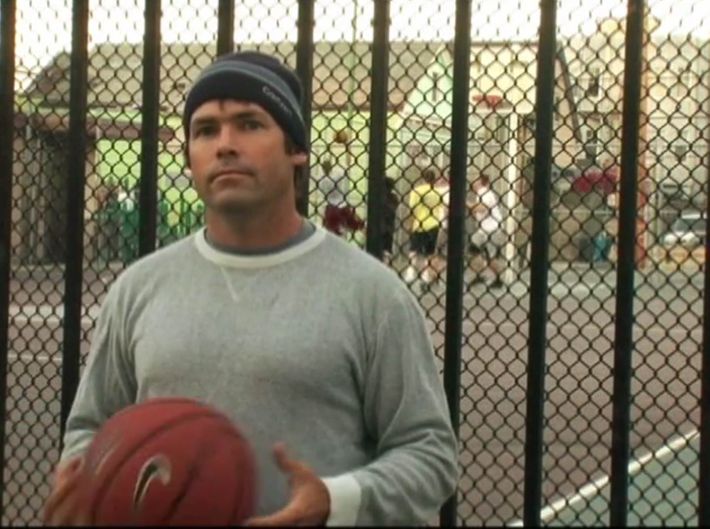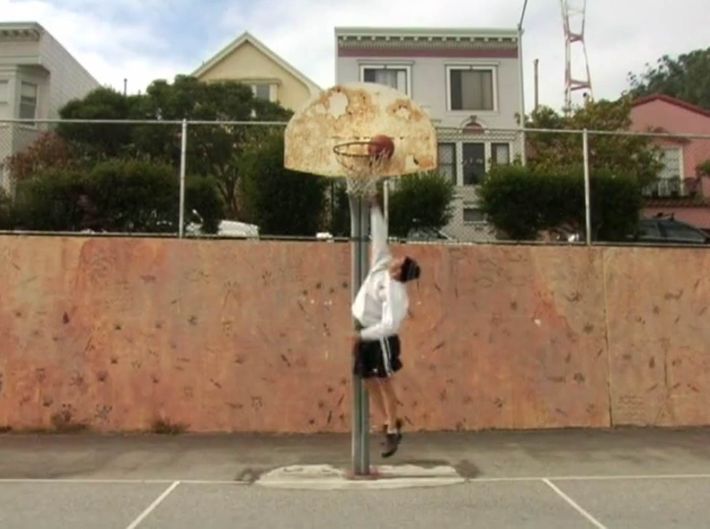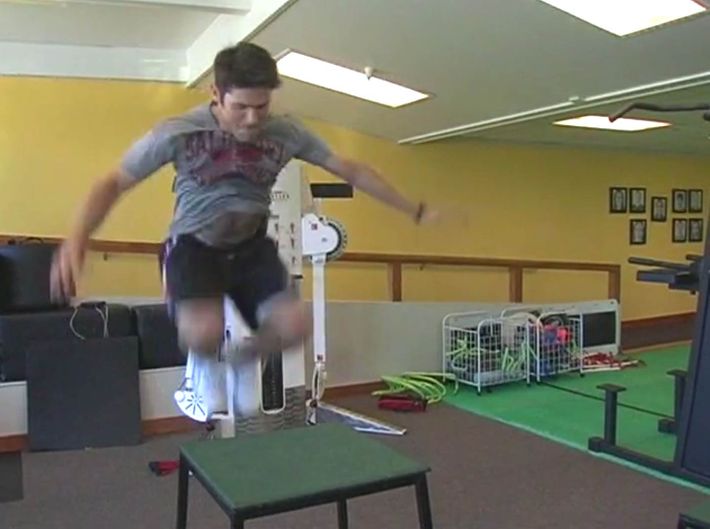
Last spring, a lanky blond sportswriter named Michael McKnight set out to dunk a basketball. “I had tossed this idea around for years, realizing with each passing birthday that my chances of success were dimming,” the 42-year-old wrote in “Learn to Dunk,” a sumptuous multimedia production that went up two weeks ago on the website of Sports Illustrated. So McKnight made a promise to himself: He’d spend long hours in the gym doing squats and lunges, dead lifts and box jumps, cleans and sprints; he’d bloody his hands on rusted rims; he’d put on a weighted vest and leap several thousand times across the playgrounds of his Los Angeles neighborhood. In all, he’d put a year into his training, 15 to 20 hours every week — a grueling, part-time dream for a father of three. “It can be done,” his piece concludes in triumph. “You can enjoy what if feels like to dunk.”
But I’m here to tell you that’s a lie. McKnight never really reached his goal, and neither have any of the other middle-aged white guys who set out on this same journey in recent years. And there are a lot of them. Though SI makes out McKnight to be a singular obsessive, he’s just the latest, hapless hero of a well-established genre: the Dunk Quest narrative. Look around the internet and you’ll find these stories everywhere, chronicled on Twitter or in local papers, or on semi-private blogs — middle-aged guys in a fruitless search for dunk-enabled transformation.
There was the 34-year-old creative director in L.A. who lifted weights six times a week, then had his quest derailed by catastrophic injury: “I caught a pass across the lane and spun towards the basket. … POP!” he wrote in his blog, I Will Dunk. There was the five-foot-eight guy who fell off the wagon halfway through a brutal training regimen (Quest to Dunk). There was the high-school teacher who practiced for three years, and then gave up without a word (One Man’s Quest to Dunk). There was the former distance runner who was working out on a hoop in his parents’ backyard (The Dunk Quest). There was the marketing professional who promised in his final post, “I’m not giving up. I’m not throwing in the towel,” and then threw in the towel (Unfinished Business). And then there was the internet entrepreneur in San Francisco who spent 18 months trying to “dunk a basketball and get in shape while helping homeless youth.” One night at the gym, he came across another guy practicing his jumps: a fellow traveler, another middle-aged software engineer who designed a financial-trading platform based around his quest (DunkBonds).
These stories share a common, mythic structure — a hubristic rise and then a fall. In Act One, the schlub puts aside his obligations to work and family so he can focus on his dunking quest. A few weeks in, he realizes that his mission will be harder than he thought: His knees throb; his hips ache; his legs begin to feel like pudding. Has he taken on too tough a task? The conflict may bring on some tension with his wife. And then, finally, after all that effort, the day arrives for triumph and redemption. He tries to dunk a basketball. And then he fails to dunk a basketball.
Always, every single time. The secret of the Dunk Quest narrative, its unforgiving clang, is that it has a tragic arc. It always comes up short. The hero jumps, he reaches for the rim, he falls back to where he started. No one ever dunks.
Some men try to finesse their way around this iron law of genre. The DunkBonds guy says he reached his goal, but in the end he needed Stickum paste to glue his fingers to the ball. McKnight claims to have dunked on the 363rd day of his yearlong quest for SI — what he calls “the day.” That’s when he screamed in triumph, guffawed, and clasped his hands together as if in prayer. But watch the video and you’ll see McKnight asked a friend to lob the ball for him — an alley-oop. He doesn’t throw it down so much as tip it in. In basketball terms, it’s really more like offensive goaltending.

Same goes for Asher Price, another high-profile Johnny-dunk-lately. Last month, the 34-year-old Jewish guy and Yale graduate (who grew up near me on what he calls the “soft-scrabble streets of Manhattan’s Upper West Side) published Year of the Dunk, a smart and entertaining memoir of his quest. For 12 months, he worked out his legs, his upper body, and his core. He practiced “finger push-ups” while he watched TV, in the hopes of strengthening his grip enough to palm a basketball. He cut out carbs and noshed on nonfat yogurt. And then, spoiler alert: His dream collapsed into an alley-oop.
Both McKnight and Price blame their failures on short fingers and their inability to hold a basketball one-handed. (A weak grip turns out to be the tragic flaw of nearly every Dunk Quest hero.) But their near-misses only reinforce the rule. If these guys couldn’t do it, who else could? McKnight isn’t quite the everyman: He’s a former strength coach for professional volleyball players who once ran a 3:30 marathon and used to play semipro football. Neither is Price, who, at almost six-foot-three, could already touch the rim with two fingers before he even started. He was also coached by trainers for the New York Knicks and an Olympic-Gold-winning high-jumper. For all the other guys — average Joes who won’t get expert help or book advances — the dream is even more unreal.
Yet the delusion of “almost” having dunked — and the theory that he’ll try again — is central to the Dunk Quest hero’s dénouement. Take the case of Josh McHugh, another middle-aged Yale graduate, just five-foot-eight, who wrote about his Dunk Quest for Outside in 2005, then produced a film about it. He failed, of course — a fact he blames on patellar tendinitis combined with the smallness of his hands. “If I could have palmed the ball, I could have dunked it. That’s my firm belief,” he told me last week. He’s now in his mid-40s, but says he’d like to take another shot someday. “Maybe once my kids go to college.”
Such relentless, tragic optimism grips the blacktop Don Quixote. “I was always super-close,” said Joel Lava, the guy who tore his ACL. “I still feel that I can do it!”
“I had these tiny, little troll hands working against me,” said Jason King, whose project, IfThisGuyCanDunk.com, ended up on ESPN. He got started in 2009, when he was working as a waiter in Seattle, with a plan to dunk by the time that he turned 30. “I thought that this would be a good ego boost for myself and a way to get back in shape,” he told me, “but I strained my hip and got a bum ankle. Frankly, in my quest to prove that I still had my youth, I did the exact opposite.”
Dunk Quest heroes come in different sizes and at different stages of decrepitude, but their missions are the same. Most set out to dunk before some impending marker of their age — a 30th birthday, or a 40th, or a 60th — as a way of showing that it’s not too late to get themselves in shape. They’re normal guys who mean to pull themselves up by their high-top laces; they’ll elevate above the rim through discipline and dedication. “It is literally about upward mobility,” writes Price in the introduction to his book, and “the very American idea … that everyone is capable of self-improvement, of rising above her [though usually it’s his] lot.”
“I have always seen myself as an everyman,” said King when I called him for an interview. “That was the idea. If this schlub can put in the work and make it happen, then imagine what you could do!”
But wait, I said, haven’t you shown, in the most public way possible, that the everyman can’t make it happen? Aren’t you the living proof that schlubs are schlubs no matter what they do?
“I certainly hope not,” he said. “That’s why I intend to revive the project. It might make more of a statement if I can come back five or ten years later and do it!”
**
It’s a funny fact of the Dunk Quest literature that its heroes never really grapple with the meaning of their stories. No one seems to notice, for example, that other guys have made the same attempt, and that they’re not the first or only ones to set out on this journey. Nor do they acknowledge that their search for manly glory has an underlying racial code — that the Dunk Quest’s “everyman” or “average Joe” is always white. They may say they’re searching for a way to “seize power and express outrage,” as Price describes it, but they barely mention that, for guys like them, who grew up in the 1980s and the early 1990s, the dunk is something black. They saw the movie White Men Can’t Jump; they want to show the world they can.

I’m like them, I guess — a middle-aged white guy born in 1976, the year of the first slam-dunk competition, when the dunk was on the rise and its racial trappings were about to be commodified. Up until that year, the move had been illegal in college play, in accordance with a rule that was meant to stifle a young Kareem Abdul-Jabbar, then named Lew Alcindor and then at UCLA, whose jumping seemed to shake the game’s foundations. “The dunk is one of basketball’s great crowd-pleasers,” Jabar is reported to have said, “and there is no good reason to give it up except that this and other niggers were running away with the sport.”
The pooh-bahs of the NBA also viewed the dunk as a ghetto play, something “schoolyard” and uncouth. By the early 1980s, though, around the time that I was getting old enough to be a sports fan, the league had changed its course. New commissioner David Stern saw the market value of the leaping style, and the slam-dunk contest, which had come and gone before, returned for good in ‘84. I had a pair of posters in my bedroom, and both showed slam-dunk champions doing what they did the best: the Atlanta Hawks’ Dominique Wilkins and his tiny teammate Spud Webb, flying up for monster jams.
Could this have been the birthplace of the geezer-dunker’s fantasy? The golden years of dunking — its integration in the ‘80s and the early ‘90s — spanned his childhood and mine. That’s when the basketball maneuver reached the apex of its awesome, manly power. There’s no more stirring image of my B-ball-watching youth than that of Knicks guard John Starks dunking over Horace Grant and Michael Jordan in the 1993 NBA playoffs. Boom shakalaka!
I didn’t grasp its racial history and meaning, but I knew the dunk was dope. And I knew it took its purest, dopest form when it was at its most destructive — when it smashed the backboard glass to bits. The most famous breaker of the rim was Darryl Dawkins, known as “Chocolate Thunder,” who did it twice in 1979, but many others followed suit. In an essay called “Attacking the Rim: The Cultural Politics of Dunking,” media scholar Davis Houck traces this display, this act of on-court combat, up through the early 1990s. A scary language of the dunk emerged during this time, armed with metaphors of violence — “tomahawks” and “hammers” rocked the rim. A slam-dunk, says Houck, was a way to bruise and bloody someone else’s manhood.
The elevation of what Nelson George called the “Black B-boy style” produced a shared experience for a certain set of kids who grew up in its thrall — the ones who grew into the middle-aged schlubs of now. For us, the culture of the dunk made sports and race and manhood into interlocking pieces of a potent sales machine — “it’s gotta be the shoes!” — which churned out sneakers, posters, video games, and feature films. The dunk stood for something both above us and beneath us — a sexy, scary-cool aesthetic of the street.
We all played Double Dribble, a Nintendo game that arrived in 1987 and was supposed to have a cheat code that allowed even us, nebbish-y gamers in our parents’ living rooms, to break the backboard on the screen. Alas, this, too, turned out to be a fantasy. (The broken backboard did turn up in later games.)
In the years since then, the NBA itself has edged away from dunks, with more three-point heaves than big-time stuffs, and a cleaner image overall. The league’s best player of the 1980s, Michael Jordan, competed in the slam-dunk contest on three occasions; his modern heir, LeBron James, hasn’t done it even once. The links between race and sex and dunking basketballs have also faded over time, thank goodness: A white guy won the slam-dunk competition in 1996, four years after White Men Can’t Jump, and the world’s preeminent dunker is now a Caucasian kid from Northern Ontario. Yet the Dunk Quest heroes of today cling to the old-school sensibility, with its outdated mores and stereotypes.
Case in point: In Year of the Dunk, Asher Price seems at pains to show how famous dunkers of the past — guys like Wilt Chamberlain and Darryl Dawkins — parlayed their prowess on the court into epic escapades in bed. Dunking, more than fame, made them studs, in this version of groupie history. “Tell your wife you dunked a tennis ball,” Price’s coach yells into his ear, “and you’re going to have a baby in nine months!” At one point Price even sends away a sample of his DNA, hoping that he might find some hidden, virile truth about himself: “Between you and me,” he writes, “a tiny part of me had hoped to find out that I was partly black. But no … I am fully Ashkenazic, as plainly white as one of those long fluorescent office bulbs.”
Price makes so much of his nonblack, Austrian-Jewish heritage, in fact, that I couldn’t help but think of another Austrian Jew. The book is haunted by castration: At 26, Price was diagnosed with testicular cancer, and he tells the story of his neutering with Freudian zeal. Chemotherapy left his scrotum bald, he says, and took away his facial hair; it made him weirdly sentimental, crying as he watched TV; and left him feeling like he’d suffered through “first-trimester blues.” This trauma seems to be the seed of Price’s urge to dunk, but the book never makes the link explicit. It’s more of an elemental theme, or an overdetermined fantasy.
The other Dunk Quest heroes don’t sub in their basketballs for testicles with such one-on-one precision, but their conflicts are the same. These are earnest, sympathetic men who feel a need to reassert their manhood, often at a moment of impotence and crisis. Joel Lava, the creative director, says he was burnt out at his job: “I’m not sure which direction to go in my career right now,” he wrote on his blog when he started training, “so I’m carpe-ing the diem with my quest.” Why not just run a marathon? Anyone can do that, he told me. (It’s true: A 92-year-old woman recently completed one in San Diego.) “A dunk has the primal appeal of physical strength. It’s the act of jumping high and throwing down with power — it’s very manly, very gladiator.”
Perhaps it’s no coincidence that Lava launched his quest to dunk right after he got married, and before he had a kid. “My wife was supportive,” he said, “but my legs were getting juiced and hard, and while I was asleep I would just kick her out of nowhere — like a quick stretch, but I’d be asleep. Then she got pregnant, so we had to put a long body pillow between us because we were afraid I was going to knee her right in the belly. I was giving her some bruises.”
Josh McHugh, the guy who made the Dunkumentary film, has a similar story: “My wife is really successful at what she does, and I think I was maybe trying to prove it to her, or to me, that even though I was married, I could still do something interesting and impressive,” he said this week. “I think after you get married, you do start to say, ‘Oh my gosh, what does this mean for my life? Am I a completely different person than I was before? Do I still have it? Do I still have the juice?’”

The Dunk Quest story sets up a challenge to its hero’s masculinity; it offers him a way to flail against his age and race and role in life. But it’s not an act of violence or abandonment, and it doesn’t offer any real escape: The hero only plays around; he head-fakes at a mid-life crisis. “I knew at the time that I would miss a lot of family dinners, bath times and diaper changes so that I could ride my bike to the gym or to local playgrounds,” says McKnight in his Dunk Quest piece for SI. Then he thanks his wife for putting up with him, and goes right back to being Dad. He may have failed at dunking, but he’s turned into a better schlub.
“It pulled me out of the dark recesses of a mild depression,” says Jason King, the hero of IfThisGuyCanDunk.com. “I was drinking too much, dabbling in drugs a little bit, and this undoubtedly changed my path. It put me in a place where I was holding myself accountable.” When his Dunk Quest failed, King started IfThisGuyCanYoga, with the goal of practicing for 90 consecutive days. Now he’s starting up a new business selling handsome yoga accessories. (Here’s his Indiegogo campaign.) “For first time I’m living a life that I’m excited about, and it all began with that dunk project,” he says.
That’s the difference between the Dunk Quest genre and an older, half-related one — the story of the self-made man. The latter tells us that anyone can lift himself rags to riches, and that all it takes is savvy and determination. But the middle-class and middle-aged white guy doesn’t have much use for a fantasy of climbing up the social ladder. He doesn’t really need to be “upwardly mobile” because he’s already at the top. When a guy like this starts tilting at the windmill dunk, he’s only looking for catharsis.
The Dunk Quest doesn’t thwart its hero’s dreams so much as purge them from his soul. It sends him on a journey back to where he started. Now he learns an earthbound lesson: He doesn’t need to learn to dunk; he only has to exorcise his fears and insecurities, so he can settle back into the rituals of being middle class. Do I still have the juice? Nope, but glad I asked.





























